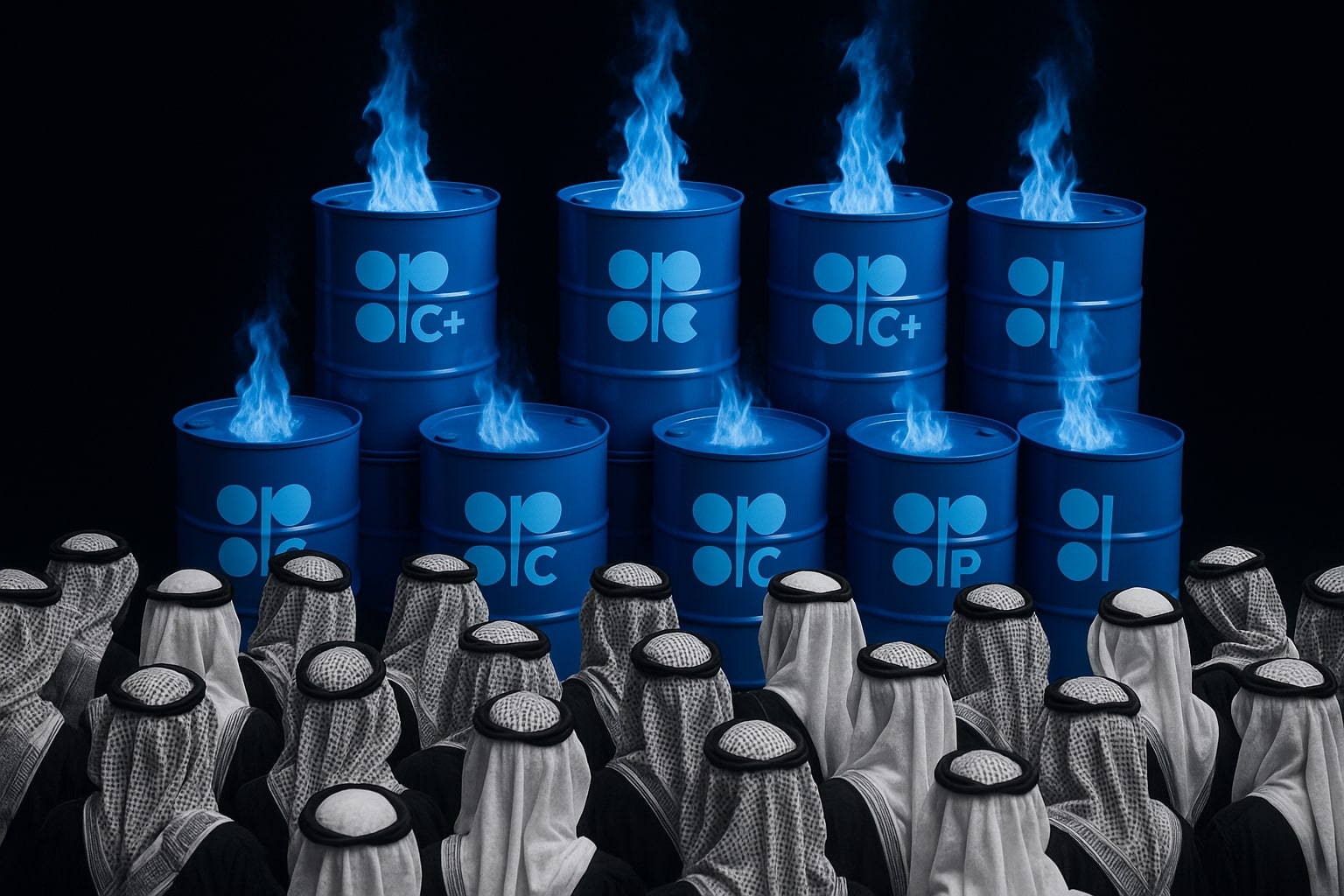
Oil Price Forecast - Oil Prices Crash Below $60 As Inventories Swell
WTI (CL=F) fell to $59.18 and Brent (BZ=F) to $63.26 as U.S. crude stocks jumped 4.4M barrels, China hoarded 900K bpd, and OPEC+ lifted exports | That's TradingNEWS
Oil Prices (CL=F, BZ=F) Drop Below $60 As Supply Surplus Deepens
Global oil benchmarks fell sharply as the market confronts expanding inventories and weakening demand. West Texas Intermediate (CL=F) declined 2.6% to $59.18, while Brent (BZ=F) slid 2.5% to $63.26, extending a three-day selloff triggered by mounting oversupply fears. Data from the American Petroleum Institute showed a 4.4 million-barrel rise in U.S. commercial crude inventories last week — the third consecutive build — signaling that U.S. refineries are processing less crude into gasoline and distillates as domestic consumption slows. Analysts expect the EIA report to confirm additional stock accumulation, reinforcing the view that demand cannot absorb current output levels.
China’s Stockpiling Strategy Masks Weak Refinery Demand
China’s crude imports continue to outpace refinery throughput, adding a hidden layer of supply pressure to the global market. Customs figures show imports exceeding refinery runs by 690,000 barrels per day (bpd) in October, the seventh straight monthly surplus. Since March, China has accumulated nearly 900,000 bpd in strategic and commercial reserves, using price weakness in the $63–$65 Brent range to build long-term buffers rather than ramp up production. The strategy temporarily absorbs excess oil from the market but exposes a deeper issue — real consumption in China remains stagnant, with refiners opting to store crude instead of converting it into fuels.
OPEC+ Output Growth And Non-OPEC Expansion Flood Markets
Supply growth from both OPEC+ and non-OPEC producers continues to overwhelm consumption. The Joint Organizations Data Initiative (JODI) reported global oil demand rising 1.4 million bpd month-on-month, yet exports climbed even faster — up 1.3 million bpd from August.
Saudi Arabia’s exports hit a seven-month high, and new production gains from the U.S., Brazil, Guyana, and Canada have added over 1.2 million bpd of incremental supply since the spring.
Crude inventories in JODI’s reporting countries increased 6.4 million barrels in September, while refined product inventories jumped 23 million barrels. This synchronized rise across regions highlights the difficulty of balancing the market, even as OPEC+ members insist that supply discipline will return in 2026.
U.S. Push For Ukraine Peace Threatens To Release Russian Crude
Reports that the United States is pushing for a peace framework to end Russia’s war in Ukraine triggered concerns that sanctioned Russian oil could re-enter global supply chains. Sources indicate Washington has drafted a proposal requiring Kyiv to accept limited territorial concessions in exchange for a ceasefire.
Traders estimate 600,000–800,000 bpd of Russian crude currently stranded in shadow fleets or floating storage could hit markets if sanctions ease. TP ICAP’s Scott Shelton warned that such a scenario could push prices into the low $50s, while Rystad Energy’s Janiv Shah noted that a reduced geopolitical premium would leave investors refocused on weak fundamentals.
Goldman Sachs Forecasts $53 WTI And $56 Brent By 2026
Goldman Sachs projects a 2 million bpd surplus by 2026 as deferred projects in Brazil, Guyana, and the U.S. come online, coinciding with OPEC+ unwinding more of its output cuts. The bank’s outlook places WTI at $53 and Brent at $56, citing declining demand elasticity and structural oversupply.
The International Energy Agency (IEA) warns the imbalance could widen if demand in China and Europe underperforms expectations. Hedge fund positioning confirms this sentiment: net long exposure in crude futures has fallen to a nine-month low, showing institutional traders have largely abandoned bullish bets.
U.S. Production Hits Record 13.3M bpd As Refining Margins Shrink
The U.S. Energy Department reported crude production at a record 13.3 million bpd, despite falling rig counts. Advances in horizontal drilling and pad optimization in the Permian Basin have allowed producers like ExxonMobil (NYSE:XOM) and Chevron (NYSE:CVX) to sustain output while reducing breakeven costs below $38 WTI-equivalent.
Refiners, however, face tightening profitability. Gasoline crack spreads fell to $19 per barrel, down from $27 last quarter, constraining refinery runs and slowing crude absorption. The result is a feedback loop of weaker utilization, higher inventories, and sustained downward price pressure on domestic crude.
Divergent Crude Grades Show Fragmented Market Pricing
While the OPEC Basket remains steady near $64.54 (-0.17%), underlying grade divergence is widening. Bonny Light tumbled 2.84% to $78.62, Mars US fell 1.34% to $70.71, and Louisiana Light slipped 0.34% to $61.66.
This dispersion underscores a fragmented global market, where regional differentials respond differently to logistics costs and sanction rerouting. African and U.S. Gulf grades are under heavier pressure as Europe reduces imports and Asian buyers secure discounted Russian and Iranian barrels, eroding the premium once enjoyed by Atlantic Basin producers.
Geopolitical Realignment: Sanctions, Saudi Partnerships, And Russian Defiance
The U.S. Treasury’s renewed sanctions on Rosneft and Lukoil will fully tighten on November 21, forcing companies to wind down contracts by the deadline. Moscow’s Deputy Prime Minister Alexander Novak claims output remains unaffected and pledged to meet OPEC+ quotas by early 2026.
Meanwhile, Saudi Aramco announced plans for $30 billion in new U.S. partnerships focused on nuclear and petrochemical integration, marking a subtle realignment of Middle Eastern energy diplomacy. These moves indicate that supply control may no longer depend solely on production levels but on alliance dynamics — between sanctions, capital flows, and bilateral deals.
Technical Breakdown: WTI (CL=F) Faces $60 Ceiling, Brent (BZ=F) Caps At $65
Technical indicators confirm a bearish structure for both benchmarks. WTI continues to oscillate below the 50-day EMA near $60, acting as a magnetic resistance. Momentum remains negative, with RSI below 40 and MACD trending lower, signaling persistent selling pressure.
FXEmpire models expect a range-bound pattern between $58–$61, with rallies toward $62.50 likely to fade. Brent follows a similar setup, consolidating between $62–$65, with a strong resistance wall near $65.50. Sustained trade below $59 would expose WTI to $56.80, marking the next major demand zone
Read More
-
FUTY ETF Outperforms S&P 500 as Utilities Surge — Analysts See 25% Upside
19.11.2025 · TradingNEWS ArchiveStocks
-
XRP ETFs XRPI and XRPR Drop as XRP-USD Holds $2.00 — $128M ETF Inflows Signal 35% Upside Potential
19.11.2025 · TradingNEWS ArchiveCrypto
-
Natural Gas Price (NG=F) Rallies 5% to $4.55 as Winter Cold and LNG Flows Ignite Bullish Momentum
19.11.2025 · TradingNEWS ArchiveCommodities
-
USD/JPY Price Forecast - Yen Rallies to 156.54 as Rising JGB Yields
19.11.2025 · TradingNEWS ArchiveForex
Demand Outlook Weakens As Refiners Cut Runs Worldwide
Despite localized rebounds, global consumption momentum remains fragile. JODI data indicates total oil demand rose 1.8 million bpd year-over-year, yet real end-user fuel usage in major economies is stagnating.
U.S. product supplied fell below 20 million bpd, India’s refinery utilization slipped to 89.6%, and European consumption remains 6.8% below pre-pandemic levels. The simultaneous rise in global inventories — both crude and refined — has eroded speculative confidence, curbing the appetite for long exposure in energy futures.
Market Perspective And Strategic Assessment
Oil’s decline is data-driven, not sentiment-based. Inventories are building at record pace, OPEC+ and U.S. output are expanding, and China’s stockpiling strategy suppresses true consumption. Without deeper coordinated cuts, the market remains structurally bearish.
WTI (CL=F) hovers around $59, and a break below $58.50 would likely trigger algorithmic liquidation toward $56–$55. Brent (BZ=F) remains capped at $65, lacking catalysts for recovery.
Verdict: Strong Sell Bias — Bearish Momentum Into 2026.
The supply glut, weakening refining margins, and geopolitical normalization collectively anchor oil in a bearish cycle. Until demand rebounds or OPEC+ implements new production curbs, WTI is positioned for continued weakness, with medium-term targets between $53–$55 per barrel.



















